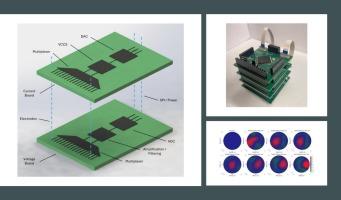A modular open-source platform for electrical impedance tomography applications
IF 2.1
Q3 ENGINEERING, ELECTRICAL & ELECTRONIC
引用次数: 0
Abstract
Electrical impedance Tomography (EIT) is a developing medical imaging technology with several benefits over current screening modalities. EIT can produce real time images for a lower cost and with fewer health risks than most common screening techniques. However, EIT is still the subject of research due to a lack of spatial resolution.
This work demonstrates an EIT device capable of injecting current into a test subject and measuring the induced boundary voltages from electrodes. The device was designed to be flexible, allowing for different avenues of research to be pursued. Commercial devices do not allow changes to imaging protocols and so are not suitable for most research. The device is split into four different PCBs that can be altered easily. This design allows additional channels or rings of electrodes to be added to the device. The bandwidth of the voltage acquisition board is between 1 kHz and 2 MHz. This bandwidth limits the frequency components of signals that the device can detect. The Current stimulation board can generate arbitrary signals with frequency components up to 2 MHz. The modular circuit design and large bandwidth of the device allow for easy changes to imaging protocols. However, this flexibility means the device is not optimized for a single use case.
The device can accurately detect targets in a saline tank when used with the open-source reconstruction software, GREIT. It has a mean Signal to Noise Ratio (SNR) of 85.4 dB and a mean homogenous reconstruction accuracy of 85.5 %. Overall, this study demonstrates the functionality and theory of an Open-Source EIT device that can be used to assist research.

电阻抗断层扫描应用的模块化开源平台
电阻抗断层扫描(EIT)是一种发展中的医学成像技术,与目前的筛查方式相比有几个优点。与大多数常见的筛查技术相比,EIT可以以更低的成本和更少的健康风险产生实时图像。然而,由于缺乏空间分辨率,EIT仍然是研究的主题。这项工作演示了一种能够向测试对象注入电流并测量电极感应边界电压的EIT装置。该装置的设计是灵活的,允许不同的研究途径进行追求。商用设备不允许改变成像协议,因此不适合大多数研究。该设备被分成四个不同的pcb,可以很容易地改变。这种设计允许将额外的通道或电极环添加到设备中。电压采集板的带宽在1khz ~ 2mhz之间。这个带宽限制了设备可以检测到的信号的频率成分。电流刺激板可以产生频率成分高达2mhz的任意信号。该设备的模块化电路设计和大带宽允许轻松更改成像协议。然而,这种灵活性意味着该设备并未针对单一用例进行优化。当与开源重建软件GREIT一起使用时,该设备可以准确地探测到盐水罐中的目标。平均信噪比(SNR)为85.4 dB,平均均匀重构精度为85.5%。总体而言,本研究展示了可用于辅助研究的开源EIT设备的功能和理论。
本文章由计算机程序翻译,如有差异,请以英文原文为准。
求助全文
约1分钟内获得全文
求助全文
来源期刊

HardwareX
Engineering-Industrial and Manufacturing Engineering
CiteScore
4.10
自引率
18.20%
发文量
124
审稿时长
24 weeks
期刊介绍:
HardwareX is an open access journal established to promote free and open source designing, building and customizing of scientific infrastructure (hardware). HardwareX aims to recognize researchers for the time and effort in developing scientific infrastructure while providing end-users with sufficient information to replicate and validate the advances presented. HardwareX is open to input from all scientific, technological and medical disciplines. Scientific infrastructure will be interpreted in the broadest sense. Including hardware modifications to existing infrastructure, sensors and tools that perform measurements and other functions outside of the traditional lab setting (such as wearables, air/water quality sensors, and low cost alternatives to existing tools), and the creation of wholly new tools for either standard or novel laboratory tasks. Authors are encouraged to submit hardware developments that address all aspects of science, not only the final measurement, for example, enhancements in sample preparation and handling, user safety, and quality control. The use of distributed digital manufacturing strategies (e.g. 3-D printing) is encouraged. All designs must be submitted under an open hardware license.
 求助内容:
求助内容: 应助结果提醒方式:
应助结果提醒方式:


